Publications
 Musicians of Mars II
Musicians of Mars II
This handbook is a sequel to CALL Publication 90-06, The Musicians of Mars: A Story of Synchronization for the Company/Team Commander, June 1990.
This short story was written to emphasize critical synchronization tasks, combat leadership principles, and factors for consideration, primarily for company/team commanders but also for leaders throughout tactical-level units. The importance of integrating and synchronizing available combat power, both lethal and nonlethal, in the decisive action environment against potential hybrid threats is critical to unit success on the battlefield.
Musicians of Mars II is written from the perspectives of two company/team commanders and the task force commander in a deliberate defense scenario against a fictional hybrid threat, based on current worldwide potential threats. It explores successes and shortcomings in the planning, preparation and execution of the defense, providing considerations and points of emphasis for tactical leaders.
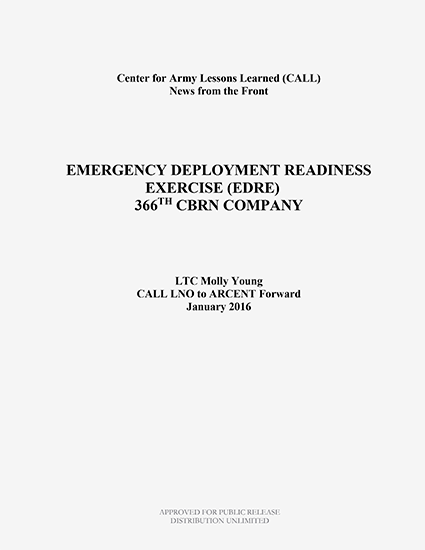 NFTF: Emergency Deployment Readiness Exercise (EDRE) 366th CBRN Company
NFTF: Emergency Deployment Readiness Exercise (EDRE) 366th CBRN Company
The CENTCOM Theater area of responsibility (AOR) has one forward deployed Chemical, Biological, Radiological and Nuclear (CBRN) Company. The 366th CBRN Company (Maneuver Support) is located at Camp Arifjan, Kuwait and assigned to ARCENT. The 366th mission is to provide CBRNE response capability to sea and air ports of deployment in the CENTCOM AOR; including contingency response to the Levant providing hazard intelligence, monitoring, and surveillance capability of CBRN agents and Toxic Industrial Chemicals/Materials (TICs/TIMs) in support of CENTCOM’s Concept Plans (CONPLANs), and bilateral agreements with countries in the AOR. The Soldiers of the 366th CBRN used this Emergency Deployment Readiness Exercise (EDRE) to practice and refine their techniques for emergency deployment via air lift within the theater of operation.
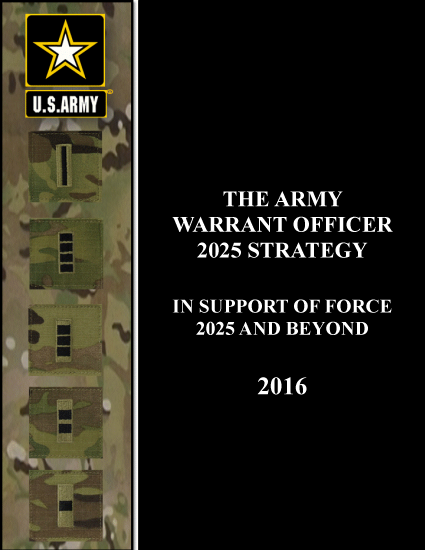 The Army Warrant Officer 2025 Strategy
The Army Warrant Officer 2025 Strategy
The Army Warrant Officer 2025 (WO2025) Strategy identifies the ends, ways, and means to ensure US Army Warrant Officers are technologically agile, adaptive, and innovative leaders - Trusted Professionals - who will maintain capability overmatch and effectively manage logistical demands to “Win in a Complex World.” This strategy was developed and is synchronized with the Army Operating Concept, Force 2025 and Beyond, Human Dimension Strategy, and the Army Leader Development Strategy. The Army WO2025 Strategy provides an effective, actionable methodology for completing existing initiatives, developing new initiatives, revitalizing warrant officer Professional Military Education (PME), and ensuring other key warrant officer leader development components are in place to meet emerging future land force requirements. Through sustained collaboration, the implementation of this strategy will ensure warrant officer initiatives are fully developed, vetted, and integrated within the Department of the Army processes. The Army WO2025 Strategy applies to all warrant officers in the Total Army.
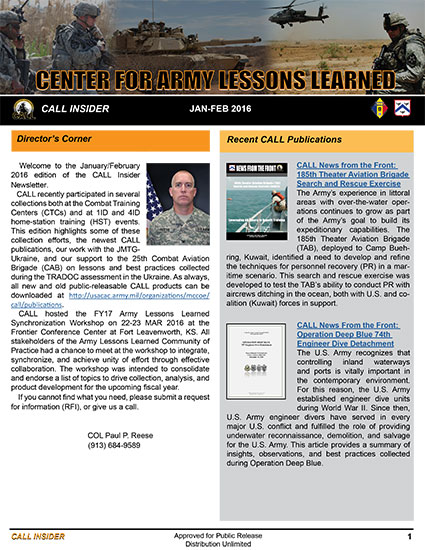 CALL Insider Newsletter Jan-Feb 2016
CALL Insider Newsletter Jan-Feb 2016
Welcome to the January/February 2016 edition of the CALL Insider Newsletter. CALL recently participated in several collections both at the Combat Training Centers (CTCs) and at 1ID and 4ID home-station training (HST) events. This edition highlights some of these collection efforts, the newest CALL publications, our work with the JMTG Ukraine, and our support to the 25th Combat Aviation Brigade (CAB) on lessons and best practices collected during the TRADOC assessment in the Ukraine.
In June 2014, CENTCOM instructed the US Army Central Headquarters to form the core of a Joint Forces Land Component Command (JFLCC), and with the addition of coalition forces, to a Coalition Forces Land Component Command (CFLCC) to conduct limited operation against Daesh (aka ISIL). As the operations against Daesh required full joint integration, CENTCOM ordered the transition of the CFLCC a CJTF, eventually becoming the Combined Joint Task Force-Operation Inherent Resolve (CJTF-OIR).
Soon after they handed over the CJTF responsibilities, ARCENT contacted the Mission Command Center of Excellence (MC CoE) with a request for a Center for Army Lessons Learned (CALL) collection team to document ARCENT Headquarters’ experience as they worked through the ASCC-CFLCC-CJTF transition, concluding with their operating as a CJTF. This Initial Impressions Report (IIR) is the collection of lessons, best practices, and insights based on the ARCENT Commander and his staff in transitioning from an ASCC to a CJTF.
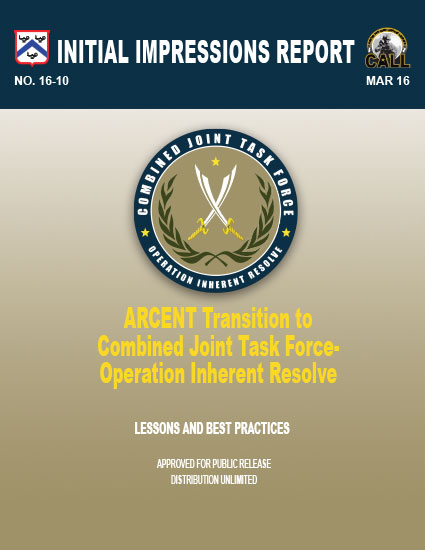 16-10: ARCENT Transition to Combined Joint Task Force - Operation Inherent Resolve
16-10: ARCENT Transition to Combined Joint Task Force - Operation Inherent Resolve
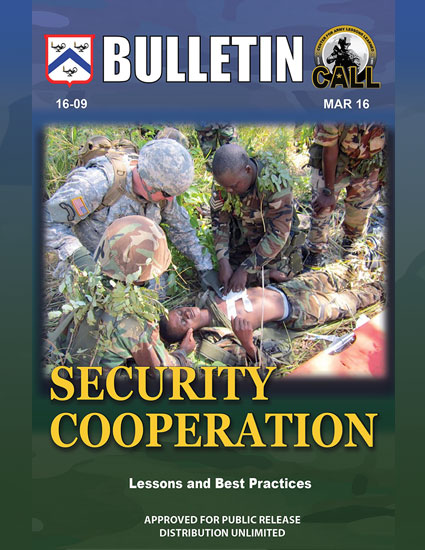 16-09: Security Cooperation Lessons and Best Practices Bulletin
16-09: Security Cooperation Lessons and Best Practices Bulletin
The routine military and interagency security cooperation (SC) activities the U.S. Army performs to deter potential adversaries and solidify our relationships with allies and partners are often described as shaping activities. Shaping the security environment is a cost-effective way to ensure peace and stability and prevent conflict. Our relationships with international partners are essential to protecting the national security interests of the United States and our allies. By helping to build the capacity and interoperability of our partners, the Army contributes to a more secure world.
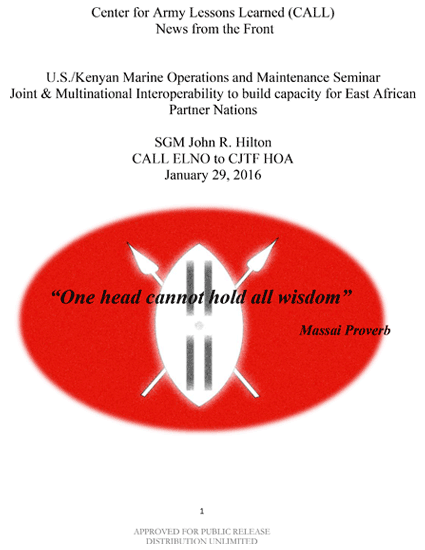 NFTF: U.S./Kenyan Marine Operations and Maintenance Seminar
NFTF: U.S./Kenyan Marine Operations and Maintenance Seminar
In January 2016 the Combined Joint Task Force - Horn of Africa (CJTF-HOA) invited members of the Kenyan Navy to Camp Lemonnier, Djibouti for a seminar focused on tactical operations and maintenance techniques. Hosting the Kenyan Navy was the Coastal Riverine Squadron 10 (FWD) and members of the Fusion Action Cell and D/403rd Civil Affairs. The event proved beneficial for both sides. Expertise and knowledge was exchanged with each side learning from each other and laid the ground work for future engagements.
I am pleased to announce the 2016 General William E. DePuy Special Topics Writing Competition. The theme of this year’s competition is “Educating the Force: What is the right balance between training and education?” With the tremendous success we had in the 2015 competition, I’m eagerly looking forward to this year’s submissions. To submit, see the instructions in the advertisement on page 1 of this issue and on our website. This edition of Military Review includes articles that will shed light on the actions of the Islamic State (IS) and help readers better understand the enemy we face. Maj. Theresa Ford posits that we must first understand the complexity of the domain of deen, an Arabic word that means faith or religion, before we can “degrade and ultimately defeat” Daesh (a term coined by some Muslims to describe IS). She demonstrates that words are the weapons of Daesh and shows how words can help defeat them. Retired British naval officer David Kibble adds to the discourse with a revealing discussion on how IS justifies its brutal actions. He examines the dialogue offered by IS in its online magazine, Dabiq, and then provides the perspective of the majority of Muslims, who have condemned IS actions as abhorrent and un-Islamic. Military Review English March-April 2016 Edition
Military Review English March-April 2016 Edition
 16-08: Decisive Action Training Environment at the JRTC, Volume XI
16-08: Decisive Action Training Environment at the JRTC, Volume XI
The shift to a decisive action training environment (DATE) challenges the sustainment warfighting function (WfF) in a manner that few sustainers have seen before. “Fighting a moving fight instead of fighting the move” describes the challenge a DATE presents to the movement and maneuver and mission command WfFs. For the sustainment WfF, this challenge becomes “sustaining the moving fight while moving the sustainment capacity.” This newsletter examines that challenge in detail. We hope the information in this newsletter will provide you with the realization that DATE sustainment means the sustainer must be three mental steps ahead of the maneuver leader to successfully support a DATE operation.
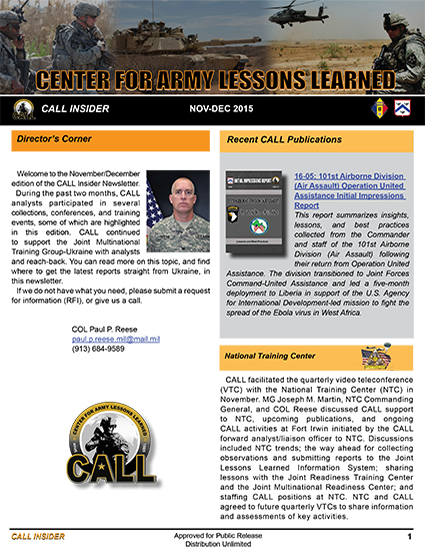 CALL Insider Newsletter Nov-Dec 2015
CALL Insider Newsletter Nov-Dec 2015
Welcome to the November/December edition of the CALL Insider Newsletter. During the past two months, CALL analysts participated in several collections, conferences, and training events, some of which are highlighted in this edition. CALL continued to support the Joint Multinational Training Group-Ukraine with analysts and reach-back. You can read more on this topic, and find where to get the latest reports straight from Ukraine, in this newsletter.
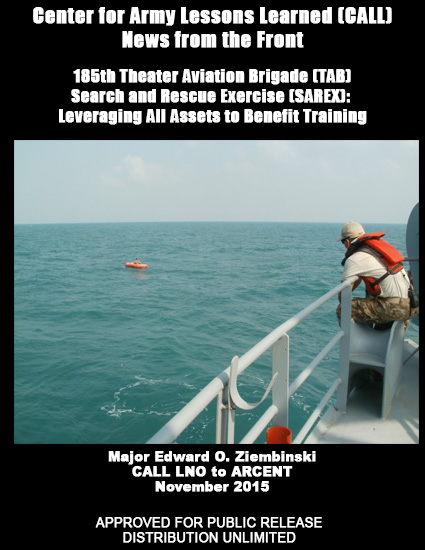 NFTF 185th Theater Aviation Brigade (TAB) Search and Rescue Exercise (SAREX): Leveraging All Assets to Benefit Training
NFTF 185th Theater Aviation Brigade (TAB) Search and Rescue Exercise (SAREX): Leveraging All Assets to Benefit Training
The Army’s experience in littoral areas with over the water operations in continues to grow as part of the Army’s goal to build its expeditionary capabilities. The 185th Theater Aviation Brigade (TAB) deployed to Camp BUEHRING, Kuwait in support of Operation SPARTAN SHIELD. Given the operational environment (OE) of the 185th TAB, they saw a need to develop and refine the techniques for Personnel Recovery (PR) in a maritime scenario. The TAB needed a means to practice these techniques as they developed them. They also needed an opportunity to learn and train on the survival equipment used in open water survival. The 185th TAB had conducted numerous land PR exercises in the past, and their aircrews trained extensively for ditching into a body of water. However, the brigade had not previously conducted a PR exercise in an open “blue water” environment. This SAREX was developed to test the TAB ability to conduct PR with aircrews ditching in the ocean, both with US forces and with coalition (Kuwait) forces in support.
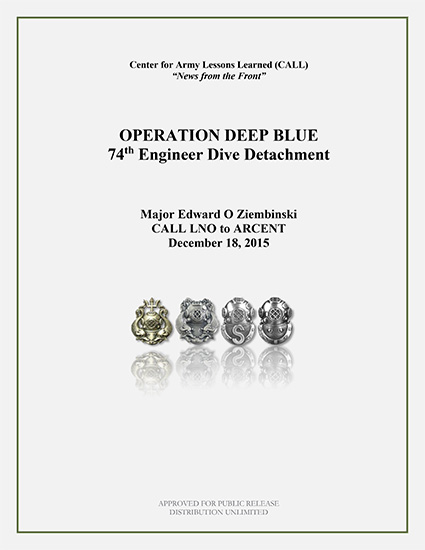 NFTF OPERATION DEEP BLUE 74th Engineer Dive Detachment
NFTF OPERATION DEEP BLUE 74th Engineer Dive Detachment
The United States (U.S.) Army recognizes that controlling inland waterways and ports is vitally important in the contemporary military environment. For this reason, the U.S. Army established Engineer Dive units during World War II. Since then, U.S. Army Engineer Divers have served in every major U.S. conflict and fulfilled the role of providing underwater reconnaissance, demolition, and salvage for the U.S. Army.
The 74th Engineer Dive Detachment is currently deployed to Camp PATRIOT, Kuwait in support of U.S. Army Central Command (USARCENT) under the Brigade Special Troops Battalion (BTSB), as part of Area Support Group (ASG) Kuwait. The two main focuses of the 74th Engineer Dive Detachment are Anti-terrorism Force Protection (ATFP) and Vessel Husbandry. ATFP involves diving to clear vessel berthing slots of obstacles, obstructions, and potential threats. Vessel husbandry includes conducting maintenance and repairs to vessels from all the services.

